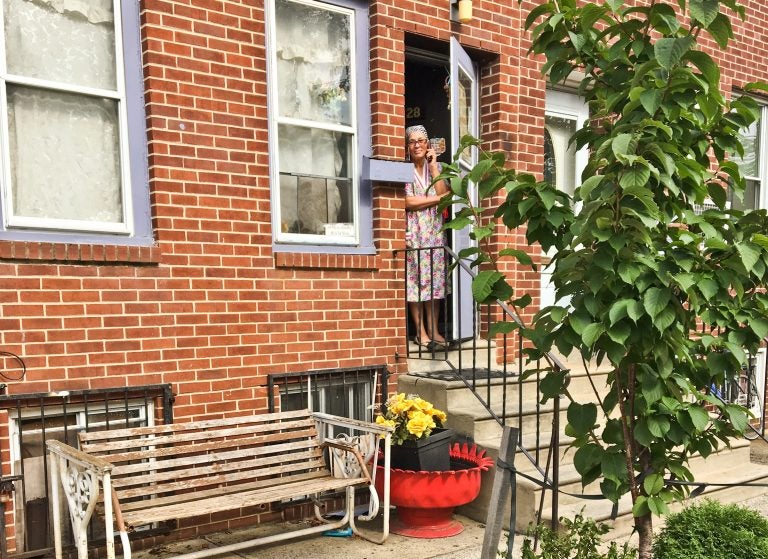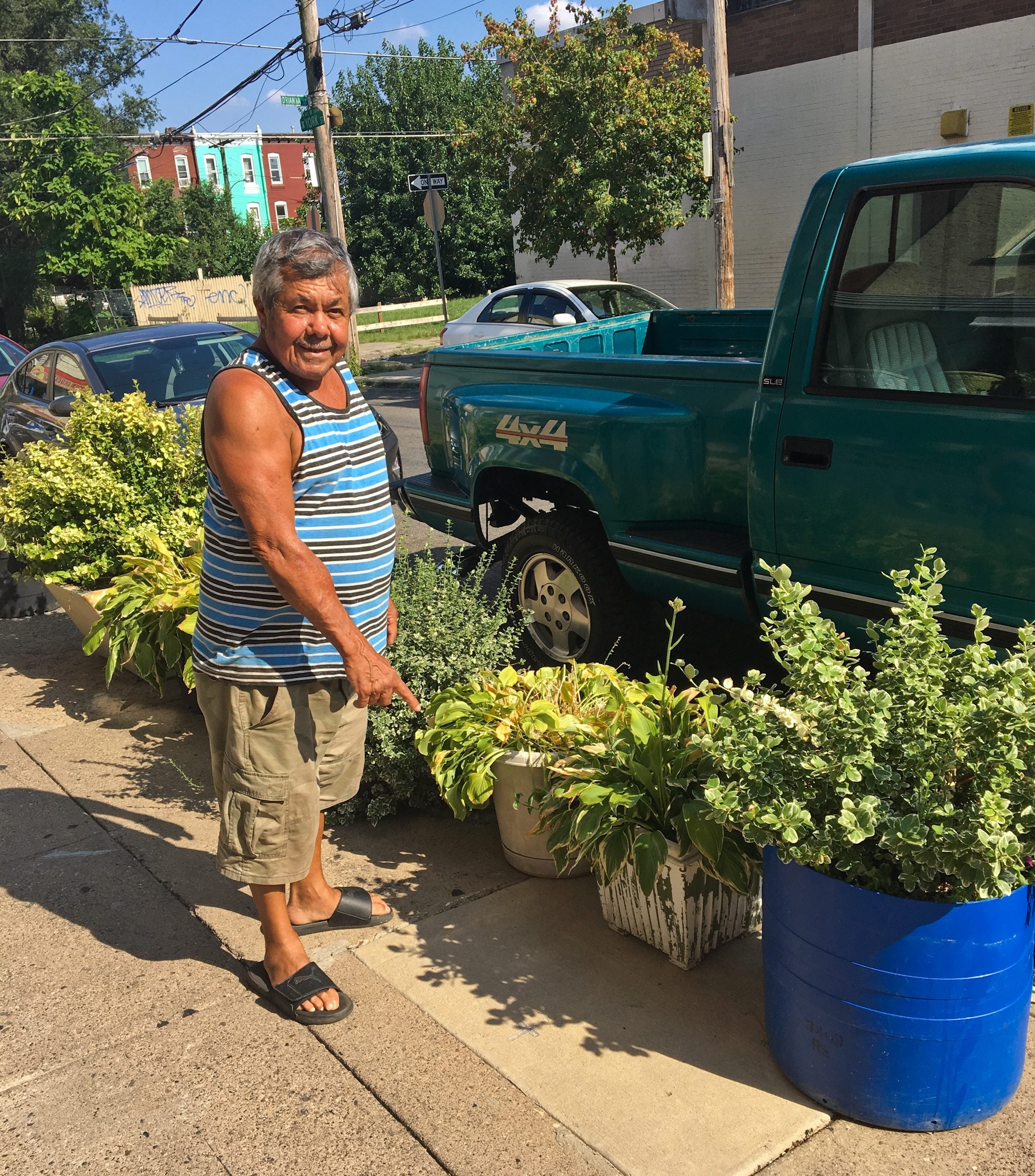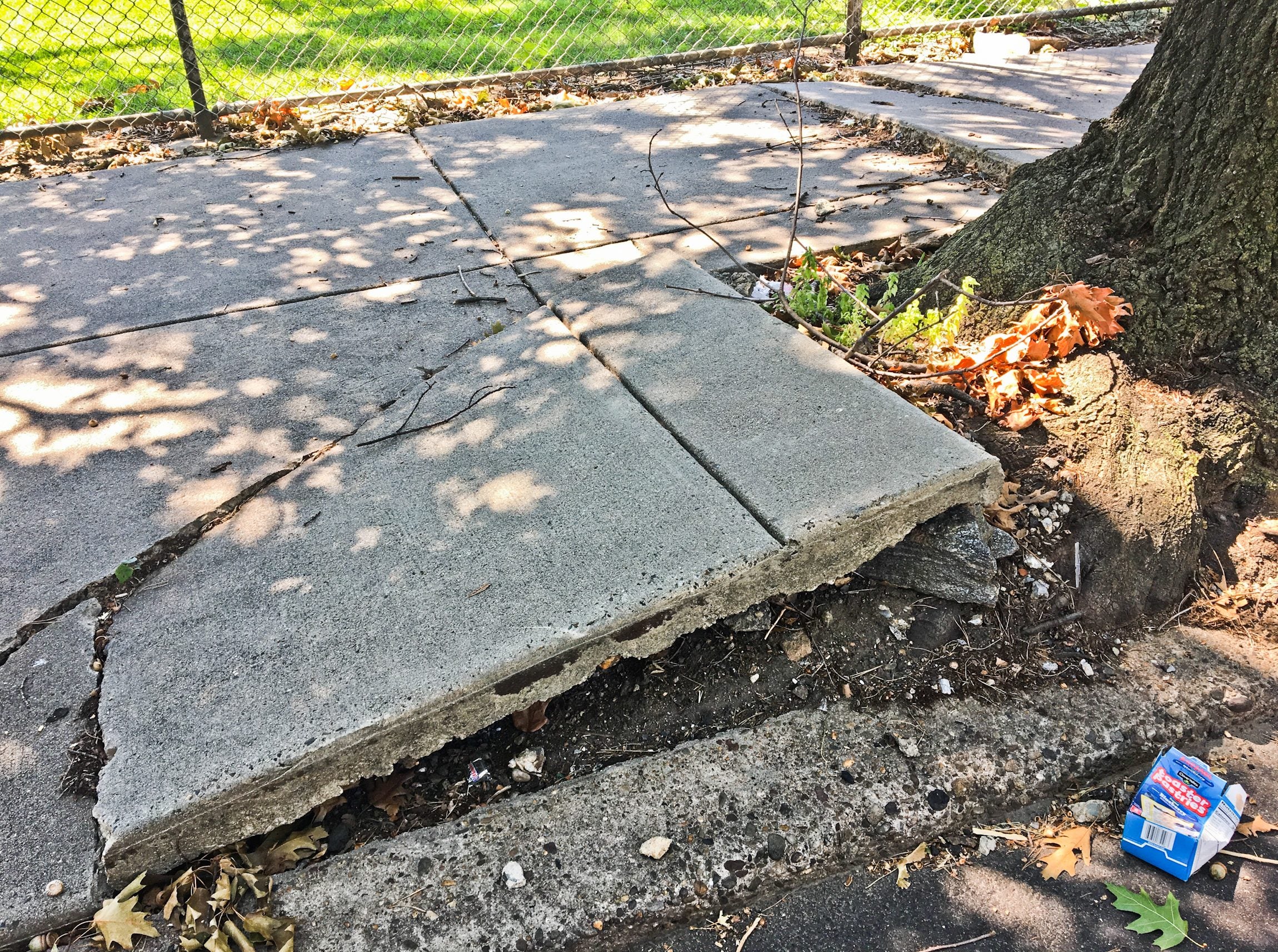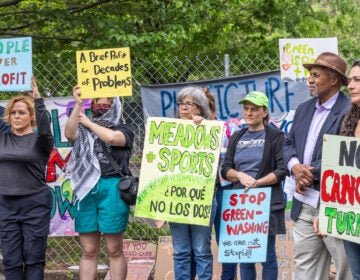Not in my sidewalk: Debunking Philly tree myths
Philadelphia needs more trees. Here is a guide to understanding why there aren’t more trees and what can be done about it.

Haydee Durán says her 1-year-old tree makes her smile when she's feeling sad. (Catalina Jaramillo/WHYY)
Trees aren’t generally controversial. They usually look nice, they provide shade and improve the air and water quality. Scientists say they even make people happier.
But when it comes to planting a tree on the street, many Philadelphians say — nuh uh, not in my sidewalk.
Angel Santiago is one of them. He loves trees, he says. Without the leafy tree next to his Kensington row home, he would probably need to run his AC all day. Yet, plant a sapling in front of his house? Nope.
“It would be beautiful,“ Santiago said, until “the tree is fully grown, and then the roots are growing out, and the concrete is lifted up. Who covers that charge, who takes on that expense?”
He describes the conundrum facing urban tree owners in existential terms.
“But then again, you can’t cut the tree because it belongs to the city. So it’s a catch-22,” he said.
Indeed, Philadelphia property owners are liable for what happens on the sidewalk in front of their lot. And that’s one of the reasons why there’s only one street tree in the four blocks surrounding Santiago’s home.
“Despite our best efforts a tree is a living thing and you can’t control everything about it — it’s not a stop sign,” said Erica Smith Fichman, who manages TreePhilly, a city program that distributes free trees to city residents.
Smith Fichman says there’s no way to deny it — trees grow, they drop their leaves, they die and they might fall. In doing that, they might disturb their surroundings, including homeowners’ property. But not always and not all species of trees. With this in mind, we’ve talked to Philadelphians across the arboreal spectrum to debunk the myths that power Philly’s tree divide.
MYTH 1: ‘There’s few trees in lower-income neighborhoods because residents don’t want them’
As PlanPhilly recently reported, poor neighborhoods have fewer street trees than wealthier ones, making them more vulnerable to the effects of climate change. The causes are complex and debatable, but city officials and tree planting volunteers say it’s not because residents in those neighborhoods don’t like them.
The city’s first community-driven plan to beat rising temperatures in Hunting Park just proved it in numbers. About 60% of the 530 residents who answered a survey said they would like to see more trees planted in their neighborhood, yet only 6% of Speanish-speakers and 20% of English speaking residents knew about the city’s free-tree program.
Jacelyn Blank, co-founder of Philly Tree People, a neighborhood association planting trees in Kensington and Fishtown since 2007, says the survey’s findings don’t surprise her in the least.
“[Residents from lower-income areas] do have values and concerns about their neighborhood, they do care about the environment, they just don’t know how, and they’re not being provided with the services that they need in order to make that impact,” Blank said. “They’re not getting the services because they don’t know the services exist.”
The vast majority of services in Philadelphia are offered in English, yet in 2016 nearly 15% of all city residents were born abroad, many living in poverty with limited English proficiency, according to a Pew report.
David Ortiz, vice president for Housing and Economic Development at Esperanza, an Hispanic organization in Hunting Park, said another reason why some residents don’t take advantage of available is because they don’t have a legal status and fear reaching out to the city.
The Pennsylvania Horticultural Society organized its first Spanish-speaking Tree Tender group in Hunting Park this year, training some 35 neighbors to plant 18 trees in the neighborhood. PHS’s Mindy Maslin says it was a success. The trees are already changing the perception residents have about them and breaking some of the myths that make them undesirable.
“For a two-block area to get 18 trees is something that makes a huge difference,” Maslin said. “It’s a beginning step for more and more people to get involved. When you have a couple blocks that are transformed by something like this, it’s a way for an entire neighborhood to come together and say: we want that.”
MYTH 2: ‘Trees get into pipes’
There is only one tree on Paula Canada’s block on 3rd Street in West Kensington, and it’s half dead. In the afternoon, the sun blasts over Canada’s home, and on extremely hot days like last Tuesday, she just sits in the dark — blackout shades down, air conditioning running on high. She says she knows trees help to cool down neighborhoods, but she doesn’t want one in front of her house.
“It interferes with your plumbing,” she said, “because of the roots.”
When people talk about the cost of urban trees, they often mention the threat of a busted pipe. But the truth is, tree roots don’t get into pipes unless they’re already broken. And not every broken pipe finds itself battling roots.
Most of a tree’s root system lives in the top 12 to 24 inches of soil beneath the sidewalk while home water and sewer lines run on average six to seven feet below the ground. So tree roots have to really go out of their way to get to them. Only some species of trees have that capacity and it only happens when there’s no other way for them to get water.
That said, Philadelphia still has many crack-prone terra cotta sewer pipes and thirsty trees are more likely to invade when there is already an opening.
That’s what happened to Canada. She says she has spent more than $3,500 to fix her plumbing after the roots of a tree in front a house she owns in West Philly ruptured a pipe. Still, she loves the tree.
“When I go out to my house in West Philly I love sitting on my porch because of the shade, it’s cool. And, you know, [because of] the beauty of a tree. And I love squirrels,” she said.
TreePhilly’s Smith Fichman says the city tries to prevent similar pipe ruptures by selecting trees with roots that don’t seek water quite so aggressively.
In 2013, the city updated its list of approved street trees with species’ drinking habits in mind.
But Smith Fichman says residents can also do their part by watering their trees properly. Only a thirsty tree will go out of its way to get what it needs.
For those who don’t want to worry about it, and can afford a monthly $8 fee, the city offers a water and sewer line protection program that covers pipe repairs and maintenance for homeowners 24/7.
MYTH 3: ‘Tree planting and maintenance is prohibitively expensive’
Planting a tree in a sidewalk or a backyard in Philadelphia, like in many other cities, can be totally free. And so is maintenance, at least for the tree’s first year.
Residential and commercial property owners can get a tree planted in their sidewalk by requesting one from the city here.
The process can take a year or even longer, depending on the city’s budget to plant trees, but the service includes an arborist inspecting the site and picking the best suitable tree for it, and a contractor cutting the cement, planting the tree, and watering and mulching it for the first year. The city also gives free yard trees to homeowners at community-hosted events each spring and fall. Since 2012, TreePhilly has given out over 23,000 trees.
Some of the city’s free maintenance services are pruning mature street trees, removing dead and hazardous ones from sidewalks, and taking trees out of the way when storms knock them down. PECO can fix issues when they fall into electric wires.
The Pennsylvania Horticultural Society also plants trees on the city’s streets. Instead of planting trees one by one on request, PHS forms volunteer groups called Tree Tenders to organize tree planting in neighborhoods across the city. Census tracts with low tree canopy, high population density, high crime and low household income get higher priority, as shown in this map. Tree Tenders receive free hands-on training and certification on tree biology, anatomy, planting and care. The program plants more than 1,500 trees every year and has been operating since 1993.
Ask people why they don’t want trees in front of their homes and most of them are going to mention leaves — big messy piles of leaves, leaves blowing around, or not being able to keep up with sweeping up leaves. Although the city’s few street sweeper trucks could help in that regard, it’s residents like Haydee Durán, who keep the sidewalks free of leaves.
“I like to clean,” Durán said in Spanish, talking proudly of her one-year-old street tree, outside her public housing apartment on 4th Street. “I clean my neighbors sidewalks, I don’t like to see the street dirty, I like to see it clean. And I love trees,” she said.
Looking at trees, she says, makes her smile when she’s feeling sad. “I talk to them. Yesterday I was telling that plant ‘What’s going on? Why are you dying? Why are you sad? Are you sad because I’m sad? Look at your friends, they’re alive, what’s wrong with you?’ She needed a little bit of water, but the rain is coming.”

MYTH 4: ‘Trees destroy sidewalks’
Kensington resident Hector Perez knows that trees can in fact damage a sidewalk. The house his parents bought in 1967, now his own, had a gorgeous tree in front of it. Perez, now 76, remembers his younger siblings running around the tree and the multiple family gatherings under its shadow.
“Here it was,” he said in Spanish, pointing to a newer looking slab of sidewalk with a cross shape made out of aluminium can tabs. “I took it out, it was breaking the sidewalk and it was lifting my neighbor’s one and he was going to complain.”
Philly Tree People’s Jacelyn Blank says trees have a bad reputation because residents have been dealing for years with the wrong kinds of trees.
“There’s a lot of the wrong species being planted along the city,” she says. “They’re most likely to grow bigger root systems because they’re a taller tree so that root system is messing up with the sidewalk.”
Parks and Rec’s Smith Fichman says people have been planting trees in Philly since its foundation, yet the study of which trees are better suited for an urban environment has only been happening in the last 50 years. And there’s been a lot of trial and error. When Dutch elm disease killed many American elm trees, the city replaced them with Ash trees and Japanese Zelkova, two reliable urban trees. But then came the Emerald ash borer beetle, which according to the United States Department of Agriculture has destroyed tens of millions of ash trees in 30 states in the last 20 years, so cities are trying to remove them.
“Now we’re learning that Zelkova, that we thought was kind of like this new great tree 50 years ago, has some really bad root systems. And so we’re not planting them in smaller planting areas,” said Smith Fichman.
Invasive species, like the Mulberry trees that grow wild and drop their fruit everywhere making quite a mess — if not picked for making jams or sorbets — or the Tree-of-heaven, a very large and fast growing Chinease species that attracts the devastating spotted lanternfly, only increase street trees bad rep.
To avoid cracking sidewalks, the city changed its contracts five years ago to allow bigger pits to be cut for the trees. Before they had to be square and all the same size. Now they depend on the tree species. And again, the city has a better idea today of what tree work better on the streets.

So even though some older trees can still destroy some sidewalks, tree lovers say it’s a myth all of them do. But again, when they do, it’s the homeowner who has to pay to fix it. According to a spokesperson for the Philadelphia Streets Department the average cost of replacing a sidewalk block is about $200. But the price can quickly climb over $1,000 depending on the size of the sidewalk, the type of material, and if it’s on a residential or commercial property. Potential personal injury lawsuit for someone falling on a homeowner’s sidewalk can be way more costly.
The Perez have several pots with plants in front of their house and big trees on an empty lot behind their property. And although they miss their old street tree they’re not willing to give them another chance.
“For what? To have problems again?,” Perez said. “They look nice, but with time, they make damage. The city plants them but we are the ones responsible, that’s the problem.”
Tony Ramos, a Puerto Rican homeowner who lives about ten blocks from Perez, thinks that’s nonsense. He joyfully waters his 3-year-old street tree every morning.
“People say they don’t like them because the roots break the sidewalk or the plumbing. That doesn’t bother me because they give shadow to the house and because I love trees,” Ramos said in Spanish. “Nature is great.”
WHYY is your source for fact-based, in-depth journalism and information. As a nonprofit organization, we rely on financial support from readers like you. Please give today.







